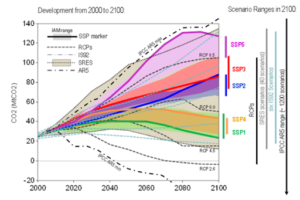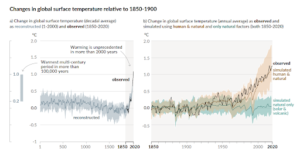The Sixth Assessment Report (AR6) of the IPCC is “unequivocal” that in recent decades humans have caused the unprecedented changes in the climate, most of which are understood to be “inevitable” and “irreversible”. These IPCC findings can be very important from XSE perspective.
Dimensions:
- Five different shared socio-economic pathways for future
- Evidences of climate change
- Uncertainties due to climate change
- How is India vulnerable to climate change?
Content:
Five different Shared Socio-Economic Pathways for future:
- Over the past few years, an international team of climate scientists, economists and energy systems modellers have built a range of new “pathways” that examine how global society, demographics and economics might change over the next century.
- They are collectively known as the “Shared Socioeconomic Pathways” (SSPs).
- These SSPs are now being used as important inputs for the latest climate models, feeding into the Intergovernmental Panel on Climate Change (IPCC) sixth assessment report 2020-21.
- They are also being used to explore how societal choices will affect greenhouse gas emissions and, therefore, how the climate goals of the Paris Agreement could be met.
- The new SSPs offer five pathways that the world could take.
- Compared to previous scenarios, these offer a broader view of a “business as usual” world without future climate policy, with global warming in 2100 ranging from a low of 3.1C to a high of 5.1C above pre-industrial levels.
- The SSPs are based on five narratives describing broad socioeconomic trends that could shape future society. These are intended to span the range of plausible futures.
- The SSPs were designed to reflect worlds in which mitigation and adaptation challenges vary from low to very high.
The 5 SSPs include:
- a world of sustainability-focused growth and equality (SSP1);
- a “middle of the road” world where trends broadly follow their historical patterns (SSP2);
- a fragmented world of “resurgent nationalism” (SSP3);
- a world of ever-increasing inequality (SSP4); and
- a world of rapid and unconstrained growth in economic output and energy use (SSP5).
Differences:
- SSP1 and SSP5 envision relatively optimistic trends for human development, with “substantial investments in education and health, rapid economic growth, and well-functioning institutions”.
- They differ in that SSP5 assumes this will be driven by an energy-intensive, fossil fuel-based economy, while in SSP1 there is an increasing shift toward sustainable practices.
- SSP3 and SSP4 are more pessimistic in their future economic and social development, with little investment in education or health in poorer countries coupled with a fast-growing population and increasing inequalities.
- SSP2 represents a “middle of the road” scenario historical patterns of development are continued throughout the 21st century.

Since the inception of the Intergovernmental Panel on Climate Change (IPCC) in 1988, scientists have been issuing warnings about the likelihood of accelerating climate change, which have been ignored.
From the First Assessment Report (AR1) published in 1990 to the AR5 in 2014, it has been emphasised that climate change is a challenge with global consequences that needs international cooperation.
The IPCC uses scenarios as a common tool to assess different forcings with respect to varying degrees of GHG warming that might occur in future situations in which outcomes are uncertain.
In the previous assessment reports, the future scenarios were derived from different representative concentration pathways (RCPs) describing different levels of radiative forcing with respect to the varying future levels of GHGs without the socio-economic narratives connected to them even being considered.
However, in the AR6, the new sets of scenarios have been derived by integrating a more realistic representation of socio-economic pathways (SSPs) with RCPs.
Evidences of climate change:
There is plenty of evidence to show that the unmatched warming caused by the higher level of GHGs in the atmosphere is mainly due to human activities.
- Scientists are observing changes in the Earth’s climate in every region and across the whole climate system, according to the latest Intergovernmental Panel on Climate Change (IPCC) Report
- Nearly all of the earth’s surface has been warming in response to the increasing levels of greenhouse gases (GHGs) accumulating in the atmosphere mainly through anthropogenic activities.
- Specifically, the global average surface temperature of the earth has increased by roughly 1.1 degrees Celsius compared with the pre-industrial baseline period of 1850-1900, which is unprecedented in the last 2,000 years.
- Warming took place at a higher rate over land compared with the ocean, thanks to the increased heat capacity of ocean waters.
- Despite the reduction in carbon dioxide (CO2) emissions that occurred because of the lockdowns during the COVID-19 pandemic, the CO2 concentration in the atmosphere reached a record high of 419 parts per million this year, which the planet has never seen in past two million years.
- Climate models were able to reproduce the observed rate of warming only when anthropogenic factors, GHG emissions in particular, were included along with natural climate forcings.

Nowadays numerical models are becoming a handy tool to evaluate the complex feedback between anthropogenic activities and global warming. The new-generation climate models include:
- the physics behind greenhouse warming along with
- realistic representations of atmospheric dynamics,
- ocean processes,
- sea ice physics,
- changes in land use and land cover, and
- other physical processes shattering the climate and forcing it to change.
Climate models are able to simulate the evolution of the earth’s climate over time on the basis of the physical principles governing the atmosphere and the oceans.
The success of the climate models in simulating the climate of medieval periods has led to them to being used widely to predict all possible future scenarios, albeit with associated uncertainty
Uncertainties due to climate change:
Climate change is bringing multiple different changes in different regions – which will all increase with further warming. These include changes to wetness and dryness, to winds, snow and ice, coastal areas and oceans. For example:
- Climate change is intensifying the water cycle. This brings more intense rainfall and associated flooding, as well as more intense drought in many regions.
- Climate change is affecting rainfall patterns. In high latitudes, precipitation is likely to increase, while it is projected to decrease over large parts of the subtropics. Changes to monsoon precipitation are expected, which will vary by region.
- Coastal areas will see continued sea level rise throughout the 21st century, contributing to more frequent and severe coastal flooding in low-lying areas and coastal erosion. Extreme sea level events that previously occurred once in 100 years could happen every year by the end of this century.
- Further warming will amplify permafrost thawing, and the loss of seasonal snow cover, melting of glaciers and ice sheets, and loss of summer Arctic sea ice.
- Changes to the ocean, including warming, more frequent marine heatwaves, ocean acidification, and reduced oxygen levels have been clearly linked to human influence. These changes affect both ocean ecosystems and the people that rely on them, and they will continue throughout at least the rest of this century.
- For cities, some aspects of climate change may be amplified, including heat (since urban areas are usually warmer than their surroundings), flooding from heavy precipitation events and sea level rise in coastal cities.
How is India vulnerable to climate change?
The report, Climate Change 2021: The Physical Science Basis released by IPCC warned that
- India, and South Asia in general, is particularly vulnerable to climate change.
- India will suffer more frequent and intense heat waves, extreme rainfall events and erratic monsoons, as well as more cyclonic activity, among other weather-related calamities, in the coming decades
- In the Indian subcontinent heat extremes have increased while cold extremes have decreased, and these trends will continue over the coming decades
- IPCC report says with high confidence that the monsoons will become more erratic: the warmer climate will lead to prolonged wet and dry conditions, which will have possible implications for severe floods and prolonged drought conditions.
- Along with the changes in rainfall intensity and distribution, changes in the cloud structure especially along the mountainous terrains of the Western Ghats and the Himalayan regions make these regions hotspots for mini cloudburst events.
- And heat waves have become more common and severe, with many cities reporting temperatures above 48 degrees Celsius (118.4 degrees Fahrenheit) in 2020.
- weather-related calamities and crises are slowing the pace of poverty reduction and increasing inequality nationwide.
- In a study published by The Lancet Planetary Health journal , researchers concluded that nearly 740,000 excess deaths in India annually could be attributed to abnormal hot and cold temperatures related to climate change.
- Furthermore, should the average global temperature rise by 1 degree Celsius (1.8 F), the resulting decline in agricultural productivity, rise in sea levels and negative health outcomes are projected to cost India about 3% of its GDP, according to a report published last month by the Overseas Development Institute (ODI) think tank.
- Another finding of the report is a drop in India’s GDP from investments made to tackle climate change impacts — among the highest in the world.
A treacherous concoction of natural and human-made reasons specific to India make it extraordinarily vulnerable to climate change.
A hot tropical climate, its geography, a heavy dependence of agriculture on stable monsoons and a coastline stretching 7000 km are some.
Runaway pollution, unplanned “development”, deforestation, lack of disaster-preparedness and a large proportion of its population living in extreme poverty are other important factors adding to India’s unique vulnerability.
Mould your thought: Discuss the findings of the latest IPCC Assessment Report. How is the Indian Subcontinent uniquely vulnerable to Climate Change?
Approach to the answer:
- Introduction
- Discuss the findings of AR6 related to global warming and climate change
- Briefly discuss future predictions based on different SSPs
- Mention the unique conditions of India that aggravate effects of Climate change
- Discuss the specific effects of climate change on India
- Conclusion
















